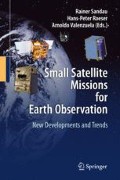Abstract
The technique called “Low-Low Satellite-to-Satellite Tracking” makes use of two-satellite loose formations for detecting the Earth’s gravity field and its space/time variations: the effect of the geopotential shows up as a variation of the inter-satellite distance, which is measured by a suitable metrology. Accelerometers are utilized on each satellite for measuring and separating the effect of the non-gravitational forces. Thales Alenia Space Italia (TAS-I) has studied for the European Space Agency a gravimetric mission of this kind, in which the inter-satellite distance variation is measured by a laser interferometer. The reference mission scenario that has been defined and studied consists of two satellites flying along the same circular orbit at 10 km relative distance and 325 km altitude. The formation control for this mission shall be designed to work in synergy with the drag-free control (necessary for providing quiet operational environment to the accelerometers), to not interfere with the scientific measurement and to minimize the use of the thrusters. Another control system is in charge of maintaining the fine pointing of the interferometer laser beam from one satellite to the other. This chapter summarizes the main results of the studies performed by TAS-I and its team on these subjects 1 2 3.
Access this chapter
Tax calculation will be finalised at checkout
Purchases are for personal use only
References
Laser Doppler Interferometry Mission for determination of the Earth’s Gravity Field, ESA Contract 18456/04/NL/CP, Final Report, Issue 1, 19 December 2005.
Laser Interferometry High Precision Tracking for LEO, ESA Contract No. 0512/06/NL/IA, Final Report, July 2008.
System Support to Laser Interferometry Tracking Technology Development for Gravity Field Monitoring, ESA Contract No. 20846/07/NL/FF, Final report, September 2008.
R. Koop, R. Rummel. The Future of Satellite Gravimetry, Final Report of the Future Gravity Mission Workshop, ESA/ESTEC, Noordwiik, Netherlands, 12–13 April 2007.
P.L. Bender, D.N. Wiese, R.S. Nerem. “A Possible Dual-GRACE Mission with 90 Degree and 63 Degree Inclination Orbits”, Proceedings of the 3rd International Symposium on Formation Flying, Missions and Technologies, Noordwijk (NL), April 2008.
Author information
Authors and Affiliations
Corresponding author
Editor information
Editors and Affiliations
Rights and permissions
Copyright information
© 2010 Springer-Verlag Berlin Heidelberg
About this paper
Cite this paper
Cesare, S. et al. (2010). Satellite Formation for a Next Generation Gravimetry Mission. In: Sandau, R., Roeser, HP., Valenzuela, A. (eds) Small Satellite Missions for Earth Observation. Springer, Berlin, Heidelberg. https://doi.org/10.1007/978-3-642-03501-2_11
Download citation
DOI: https://doi.org/10.1007/978-3-642-03501-2_11
Published:
Publisher Name: Springer, Berlin, Heidelberg
Print ISBN: 978-3-642-03500-5
Online ISBN: 978-3-642-03501-2
eBook Packages: Earth and Environmental ScienceEarth and Environmental Science (R0)

